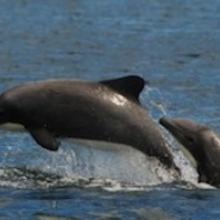On Monday, June 27, I took the Casco Bay Ferry in Portland to Long Island Maine with Heather Tetreault and Sarah Paquette from the Maine Lobstermen's Association and Kate Dawson from Maine Sea Grant to meet with local lobstermen and women as part of our project to document lobster fishing practices in Maine. We were lucky to be traveling through the picturesque southern Maine islands on one of the most beautiful days of the summer so far.
[[wysiwyg_imageupload:172:]]
This trip was the 39th and last for Heather, who has spent the last year surveying fishing communities along the coast of Maine. She has met with lobstermen to discuss how gear is configured in their community, where and when they fish (or don't fish), and what fishing practices have the potential to reduce the risk of whale entanglements.
Long Island is in the Casco Bay area of Lobster Management Zone F. There are only about 20 active fishermen on Long Island, most of who only fish in state waters (within 3 miles of the shore). Although there are only a small number of fishermen on the island, there are hundreds of others who hold permits to fish in Casco Bay, which has led to a high level of trap congestion and buoy lines run over by boats.
[[wysiwyg_imageupload:173:]]
We arrived on Long Island and immediately received friendly offers for rides up to the school where the meeting was being held, but because it was such a pleasant day, we decided to walk. As we slowly traveled the mile to the school we saw evidence that marked the island as a fishing community - lobster traps, ropes, buoys and boats - in front of nearly every home.
Seven lobstermen and one woman joined us up at the school for the meeting (which is a great turnout!). Heather first gave a short presentation on whale entanglements. She put up a map made by the Ocean Conservancy that shows the locations of six whale entanglements between 1997 and 2005, which are known to have involved gear set by Maine lobstermen. Many more entanglements have happened (around 82% of the right whale population has entanglement scars), but it is difficult for researchers to trace the event back to where the gear was set, because most whales can swim away with the gear attached to their bodies. Seeing that one entanglement involved gear that was set in Casco Bay, one lobsterman was genuinely surprised, saying he "hadn't heard that there were that many entanglements in Maine."
After the presentation, Heather had everyone fill out a gear survey, which asked for a drawing of how their gear is set up on the seafloor and what the surface buoy system looks like. Everyone fishes differently and part of our project is to document the range of gear configurations.
[[wysiwyg_imageupload:175:]]
Heather then had the lobstermen indicate on a map where and when they fish (information which will be modeled, but individual information will remain confidential). This was the most entertaining part of the evening. The lobstermen eagerly rolled out the maps and then quickly started to quarrel over where to draw the lines: "well you go out here, don't you" and so-and-so "fishes all the way out here."
[[wysiwyg_imageupload:176:]]
After the meeting we had some time to kill before the ferry arrived, so David Johnson, Steve Train, and Craig Stewart drove us around the island and showed us some of their gear and how they set it up. Seeing the gear in person, how everything is put together and how it wears out and is repaired, really helps to understand how lobster fishing works.
[[wysiwyg_imageupload:177:]]
Kate, from Maine Sea Grant, took video of the trip, which will be posted here when it is completed. She asked Steve and David to talk about why they participate in meetings such as the ones Heather has organized. They both said that they felt it was important to participate in the management process and not just complain about the regulations after they went into place. We really appreciate their participation and their hospitality.
[[wysiwyg_imageupload:179:]]
Featured Bycatch Species

Historically, the Chilean dolphin has been hunted both for food and for crab bait (Reeves et al 2008).
